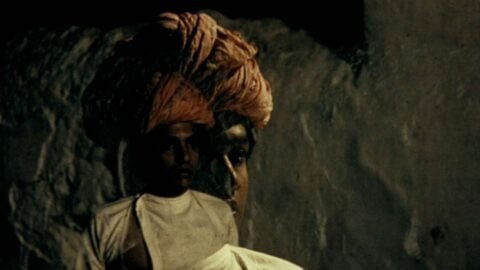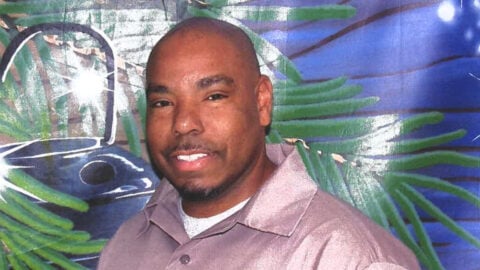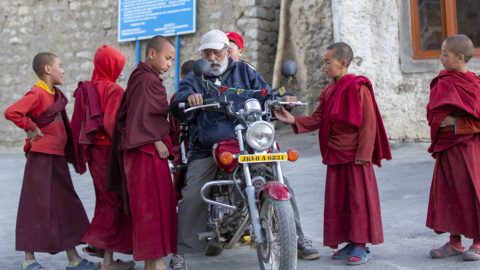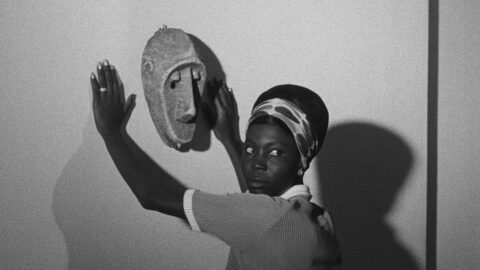Making Film: Behind the Scenes with Beckett
Ross Lipman’s documentary Notfilm screens with Beckett’s Film on Tuesday, February 23 as part of Film Comment Selects. The following article was originally published December 2014 when Notfilm was in postproduction.

He scurries through the rubble, a furtive man in shabby clothes. Afraid of being seen, he hides from the camera following him, pushing aside aghast pedestrians and stumbling over construction detritus in his hurry. In a way he resembles Estragon in Waiting for Godot, fleeing an attack from assailants. Or the vagrant in Molloy, retreating to his mother’s room so he can “finish dying.”
His name is “O,” and he is the chief figure in Film, the only screenplay written by Samuel Beckett, and he is played by Buster Keaton. Fifty years ago, Beckett and Keaton collaborated on the movie in New York City, in an unlikely pairing of two of the greatest artists in their respective fields. Film won Keaton a standing ovation at the 1965 Venice Film Festival and received modest distribution in the United States. But for years it was surrounded by tantalizing rumors of deleted scenes, tension on the set, and drastic changes to the script during shooting.
A fuller picture of the making of Film has begun to emerge with the revelation of some little-known documentation that offers fresh perspectives on its creators. In the forthcoming documentary Notfilm, filmmaker and archivist Ross Lipman reveals audiotapes of Beckett in production meetings with Film director Alan Schneider and cinematographer Boris Kaufman, outtakes of Keaton at work, and, amazingly, a reconstruction of the movie’s long-lost original opening scene.
Film starts with Barney Rosset, owner of the influential Grove Press. His authors would include Nobel laureates like Beckett, Pablo Neruda, Octavio Paz, and Harold Pinter. Rosset was also a central figure in the landmark obscenity trials involving Lady Chatterley’s Lover and Tropic of Cancer. But what he really wanted to do was make movies. A veteran of the Army’s Signal Corps, Rosset produced an independent feature in 1948 about racism called Strange Victory, directed by Leo Hurwitz and not a big hit at the box office. In the 15 years it took him to put together another movie project, he built Grove Press into a major force in the American cultural landscape.

Rosset asked Beckett, Harold Pinter, and Eugène Ionesco to contribute short screenplays for what he as a three-part omnibus film. Beckett began working on what would become Film in the winter of 1963, confiding to his friend Alan Schneider that the project “petrified” him. What eventually emerged was a complex, idiosyncratic story about different modes of seeing. In the script, “O”—the name represents not only a character but a point of view—is pursued by “E,” a separate means of perception.
The Russian-born Schneider had directed the American premieres of Beckett’s Waiting for Godot and Edward Albee’s Who’s Afraid of Virginia Woolf?. Although he had never worked in motion pictures before, Schneider agreed to direct Film. Beckett corresponded frequently with him about the project, discussing casting as well as how to shoot the script. “I loved it, even when I wasn’t completely sure what Sam meant,” Schneider wrote in his autobiography Entrances.
Since the film was essentially a silent comedy, Beckett and Schneider hoped that Charlie Chaplin might play the lead. (He refused; as a rule, he declined to read scripts submitted to him.) They also approached Zero Mostel and Jack MacGowran, both veterans of Beckett productions. As the shoot grew closer, they considered Alec Guinness and then Buster Keaton.
According to James R. Knowlson, Beckett’s authorized biographer, the playwright had a “longstanding” interest in film dating back to the 1920s. Beckett was fond of silent comedy, in particular Chaplin’s The Kid and The Gold Rush. He also watched some of Keaton’s features: Sherlock, Jr., The Navigator, Go West, The General. Beckett even considered a career in cinema, writing the Russian master Sergei Eisenstein around 1936 to apply to be his trainee.

Opinion is divided about how strongly silent film comedians influenced Beckett. As Bill Irwin, a noted clown and the first performance artist to be awarded a MacArthur Fellowship, put it: “Some people feel that baggy pants and Beckett, it’s a complete connection, it makes perfect sense. Some don’t feel that way. But to me, he did seem to have an eye, a visual memory, for baggy pants comedy.”
For Ian McKellen, who has toured the world in a production of Waiting for Godot with his friend Patrick Stewart, the influence is clear. “In the printed text of Godot, halfway through the first act, Beckett has his only footnote: ‘All four wear bowlers.’ This sets Didi, Gogo, Pozza, and Lucky in their time, when most men wore hats,” he wrote by e-mail.
“But all in bowlers? In the snatches of music-hall routines which both pairs of characters have displayed, the audience is reminded of bowlered comics, Laurel and Hardy in particular. (Didi and Gogo might be the stage names of Vladimir and Estragon.) . . . It’s a small side-step to Buster Keaton, another master comedian whose trademark character was a victim battling against the world’s madness.”
Irwin agrees that Keaton’s screen character must have appealed to Beckett: “There’s something in Keaton about an interior life broiling below the surface. It’s similar to what you see in Patrick McGee as he does Krapp’s Last Tape, which Beckett wrote for him. And Beckett may have been drawn to the fact that for Keaton, smiling was not part of the repertory.”
 Keaton was famous for his stern, unyielding visage—”The Great Stone Face,” as he was sometimes called—but just as important to his success on screen were his indomitable spirit, his focus and perseverance, his refusal to give up when buffeted by fate. These traits played out in his real life as well. A star in silent film, Keaton went into a decline in his later years. But he never quit his career.
Keaton was famous for his stern, unyielding visage—”The Great Stone Face,” as he was sometimes called—but just as important to his success on screen were his indomitable spirit, his focus and perseverance, his refusal to give up when buffeted by fate. These traits played out in his real life as well. A star in silent film, Keaton went into a decline in his later years. But he never quit his career.
“He was taken for granted somewhat,” film historian Leonard Maltin said about Keaton. “He still worked, he turned up on television with some frequency, but he should have been treated like royalty.”
Keaton accepted $5000 for three weeks’ work. In his autobiography, Schneider was dismissive of the comedian when they first met in Keaton’s home in Los Angeles. For one thing, Keaton, who had turned down the role of Lucky for the American premiere of Waiting for Godot, didn’t much like Beckett’s piece. “The script was not only unclear, it wasn’t funny,” Schneider recalled.
What’s more, Keaton had timed the script, which came out in his mind to four minutes, not the 30 minutes that Beckett had planned. “He’d be glad—for a fee—to supply some ideas,” Schneider noted, adding that they were “from 1927.”
Beckett flew to New York (it was his only trip to the United States) in July 1964, to meet with Schneider, Rosset, and the production team. He would remain for most of the shoot, despite what he called “desperate” heat and humidity. “Had to stop every few yards and hold on to things, chiefly pillar boxes,” he wrote in a letter.
At first the team met at Rosset’s house on Long Island, where their discussions were tape-recorded. For years the recordings languished in obscurity, until Lipman approached Rosset about restoring Film for the UCLA Film & Television Archive. Rosset provided Lipman with the audiotapes—a rare find because of the paucity of audio records of Beckett’s voice.
“One of the neat things about these tapes . . . is that he’s in active debate with the production team,” Lipman said. “You hear his in-depth conversations with Alan Schneider and Boris Kaufman as they try to determine how to represent different types of vision on film, a central concept of Film itself.”
Kaufman, Film’s director of cinematography, had won an Oscar shooting On the Waterfront, and had just finished filming The Pawnbroker. (Beckett attended a pre-release press screening during his visit.) He had also photographed three of Jean Vigo’s greatest films: À propos de Nice, Zéro de conduite, and L’Atalante. He was also the brother of Dziga Vertov, the Russian filmmaker behind The Man with a Movie Camera, perhaps cinema’s most famous self-reflexive film.
“Notfilm traces all these parallel paths,” Lipman said. “There’s the relationship between Kaufman and Vertov, between Kaufman and Vigo, and then the cross-pollination between Kaufman, Keaton, and Beckett, who in Film are analyzing cinema itself. Because Keaton, too, had all these self-referential bits in his films.”

Keaton’s silent films—the 19 shorts and 11 features he personally supervised—have a technical sheen and aesthetic curiosity that have never been matched. As a screen character, Keaton always knew that a camera was watching him. He covers the lens to protect his wife’s modesty in One Week, throws a kiss goodbye to viewers when he falls off a cliff in The Three Ages, and in the dazzling Sherlock, Jr., he leaves a projection booth and enters into the very movie he has been showing on the screen.
“What may have appealed to Beckett, and to everybody else for that matter, was Keaton’s mathematical sense,” Irwin suggested. “There’s a precision and formality to his work. Take One Week, where he has to build a house following numbered instructions, but the numbers are all wrong.”
Schneider introduced Beckett to Keaton in the comedian’s hotel room just before the production began. By all accounts it was not a happy meeting. Keaton drank beer, watched a baseball game on television, and gave monosyllabic answers to Beckett’s questions. “They had nothing to share,” Schneider wrote later, although Beckett did agree to let Keaton use his signature pork-pie hat in the film.
Although Film was a low-budget, independent production, Keaton’s appearance in a Beckett work was still pretty big news, covered by both The New York Times and The New Yorker. Among the crowd watching was the French director Alain Resnais.

Thirteen-year-old Leonard Maltin also came to the shoot.
“As a kid I had gotten hooked on silent movies, particularly silent comedy,” he recalled. “So Keaton loomed large in my consciousness. The opportunity to meet him just presented itself. The irony is that standing on that set at the very same time, although I didn’t know it, was Buster’s friend and fellow actor James Karen. For the past 30 years he’s been one of my closest friends.”
Irwin also singled out Karen for his impersonation of Beckett on the set. “I remember Jimmy quoting him, in a brogue, saying something like: ‘Mr. Keaton, Mr. Keaton, could you do two-and-a-half blinks?’“
Film has always been controversial, for Beckett and Keaton fans alike. One reason may be that fully a quarter of the movie was discarded by the filmmakers. The original opening scene featured elaborate shots of a dozen actors as they moved down a street, choreographed to very specific camera movements. When they viewed the material later, Schneider wrote: “The lighting was gloomy. The performances, except for Buster’s, were terrible. The group scenes suffered so badly from that strobe effect that they were impossible to watch.”

Unfortunately, the filmmakers had already burned through a significant portion of their budget on that one day, and couldn’t possibly reassemble the cast for retakes. Beckett, reputed to be so protective of his work, simply scuttled the material and came up with a new opening.
“That’s the way Film has been known for years,” Lipman explained. “When Barney talked about the film he said, ‘We spent all this money, we did this elaborate scene, and it’s lost.’ But then during one of my many visits, Barney said he had some outtakes under his sink.”
Lipman found several rusty cans of film that included footage of the missing scene. Using digital tools, he found that he could reconstruct much of the scene, correcting camera anomalies likes bumps in camera operator Joe Coffey’s pans.
He also found new Keaton footage. “Many of his best takes wound up on the cutting room floor,” Lipman said. “They didn’t fit in with the overall choreography of Beckett’s vision. Or sometimes Keaton’s face would creep into the shot. Conceptually you could not see Keaton’s face from beyond a 45-degree angle, at least until the end.”
 Schneider praised Keaton’s professionalism in Entrances, even if he didn’t get the comedian’s sense of humor. He quotes Keaton as remarking: “I’m beginning to catch on to this Shakespeare stuff.” “He knew by the time we were finished that it all ‘meant’ something, even though he still was not sure exactly what,” Schneider added.
Schneider praised Keaton’s professionalism in Entrances, even if he didn’t get the comedian’s sense of humor. He quotes Keaton as remarking: “I’m beginning to catch on to this Shakespeare stuff.” “He knew by the time we were finished that it all ‘meant’ something, even though he still was not sure exactly what,” Schneider added.
After the Venice screening, Keaton told reporters, “I don’t know what it was all about, perhaps you can tell me.” The comedian moved on to new projects, including Richard Lester’s adaptation of A Funny Thing Happened on the Way to the Forum. As for Beckett, he wrote that he enjoyed his time in New York. He attended a Mets doubleheader at Shea Stadium and even visited the World’s Fair in Flushing, Queens. But he never returned to the United States. And although he wrote and directed for television, he never worked in motion pictures again.
Film did not turn a profit. In fact Rosset spent so much money on it that he had to cancel plans to shoot the Pinter and Ionesco pieces. But a few years later he earned a windfall from distributing the notorious Swedish import I Am Curious (Yellow).
Lipman and producer Dennis Doros are still piecing together Notfilm, and you can find more information about the film at its website. But even at this early stage the documentary is changing how we perceive Film.







